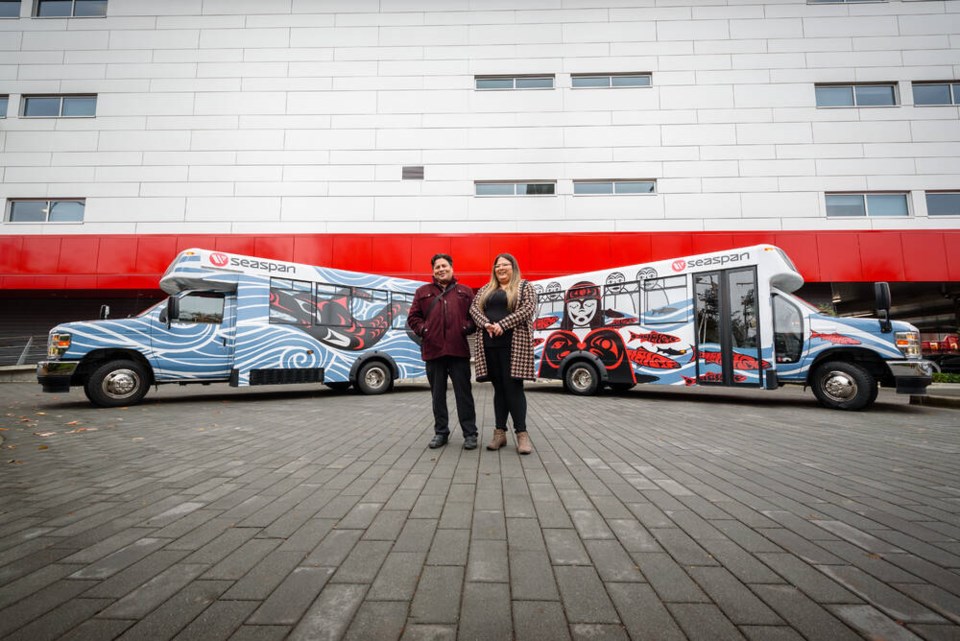Some of North Vancouver’s most compelling art isn’t always found in its galleries. Sometimes it can be spotted walking the streets or, in the case of two new Indigenous artworks, on the morning commute.
Count yourself lucky and you might just find yourself parked up at a red light during rush hour traffic alongside one of Seaspan’s new electric employee shuttle buses.
The two shuttle buses feature the custom artwork of Sḵwx̱wú7mesh Úxwumixw (Squamish Nation) artist Ray Natraoro and səlilwətaɬ (Tsleil-Waututh Nation) artist Olivia George, with each wrapped in traditional, Indigenous designs that celebrate the local waters.
Master carver Natraoro created a nautical scene that depicts a black and red killer whale set against swirling waves, chosen because the marine mammal represents “family and the unity of the sea kingdom,” he said.
“The killer whale is the protector and the one who brings balance to the sea kingdom with strong family connections. It supports knowledge sharing from one generation to the next,” he said.
The shuttle design crafted by 29-year-old George pays tribute to Chief Waut-Salk, a former chief often found at the centre of Tsleil-Waututh legends and stories. Known for drumming and singing to salmon, the scene depicts him in the centre of the Inlailwatash (Indian River) in the midst of the salmon run, surrounded by members of his Tsleil-Waututh Nation family.
“Salmon is an important sustenance to thrive throughout the winter, and Waut-Salk was a sacred protector, a keeper of knowledge, land and people,” she said. “He kept the balance with our teachings on how to treat all beings and the environment. We can strive to protect each other, the land and animals, like Chief Waut-Salk did.”
The two artists answered a call for submissions put out by Seaspan earlier this year, for two battery-electric shuttle buses that would replace the gas-powered commute buses for all North Vancouver-based Seaspan employees.
The new eco-conscious buses will shuttle staff to and from Seaspan worksites at Vancouver Drydock, Vancouver Shipyards and their head offices on Pemberton Avenue.
Natraoro, who alongside George was also chosen to create and design the visual identity for the Invictus games earlier this year, said having Indigenous design on the roads during the busiest time of the day helps educate and raise awareness of Indigenous culture.
“To create a contemporary art piece on a bus was fabulous, because it expands our art and tells stories of the people of the land, all while creating wonderful artwork for people to see,” he said. “The visibility of our people and our art in our own territory is very significant.”
Scott Boylan, transportation lead at Seaspan, said the inclusion of the two new shuttles to Seaspan’s fleet was “nothing short of revolutionary” for the marine services company.
“This represents another step forward in our sustained, continuous journey to be responsible stewards of the lands on which we call home, and what a privilege to showcase this beautiful artwork across North Vancouver every day,” he said. “We’re honoured to partner with these talented Indigenous creators and to support local artists.”
Mina Kerr-Lazenby is the North Shore News’ Indigenous and civic affairs reporter. This reporting beat is made possible by the Local Journalism Initiative.



